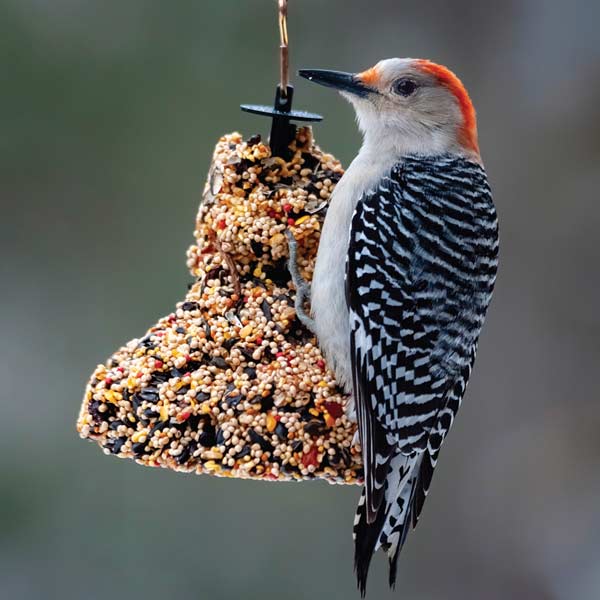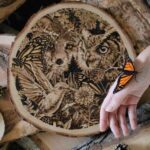
“Feed the birds, that’s what she cries / While overhead, her birds fill the skies.”
It was the 7th of May in a year I don’t remember, but my recollection of that day is still vivid. Dressed in a black and white tuxedo and topped off with a brilliant red iridescent head, the woodpecker was doing a full reconnaissance of my bird feeding station – a weathered 16-foot cedar pole I had planted in the ground. The pole supported a 14-inch-square plywood platform that was strewn with shelled peanuts. Although I’m blessed with a large, treed property where several pairs of red-headed woodpeckers nest, I had never succeeded in luring this threatened species to my bird feeder.
Feeding wild birds is an obsession with me. I have watched and fed them for over 60 years. I’ve paid attention to what makes them tick, and over time I’ve come to realize that there’s a formula to attracting birds to feeders. I’ve also come to realize that, as with most challenges in life, success lies in the details, simple but specific details.
Take the cedar pole for the red-headed woodpeckers for example. Why did that red-headed woodpecker finally come to my feeder? It took some time but I figured it out.
Woodpeckers can’t land on horizontal or flat surfaces; they need a vertical surface. The cedar pole landing strip I planted in my yard also had a tray feeder attached to it. I made one small alteration to that feeding tray which I believe was also key to coaxing the woodpeckers to become regular visitors. I cut a section out of the feeding tray so the woodpeckers could still use the pole as a vertical perch. As a result, they were able to shimmy down the post through the cutaway section and still access the peanuts on the tray – while feeding upright. Perfect!
That weathered cedar pole acted as a landing strip for the woodpecker and for other species as well. Soon nuthatches, brown creepers, and every other kind of woodpecker in the neighbourhood – even a pair of pileated woodpeckers – began using it. The specially altered feeding tray was a very simple solution, but one I had overlooked for many years.
That’s just one example, but there are other things to think about when you are setting up your feeders: Birds are always on the lookout for predators, so they approach feeders with caution for good reason. An inviting feeder – whether a tray, a platform or a silo – is one that has nearby shelter or provides an element of safety for birds. If a bird is exposed on a feeder, it is vulnerable to aerial attacks from swift flying raptors such as Coopers and sharp-shinned hawks.
Ground feeding birds such as juncos, mourning doves and American tree sparrows have different feeding patterns from woodpeckers. They prefer platform or tray feeders. I built a large 4 x 4 foot plywood platform and positioned it five feet above the ground so that it is at eye level in front of my picture window. It is bordered by boxwood shrubs, providing a large space for the ground feeders to dine. On each side of the boxwoods is a cedar hedge so the little birds hop all the way to the feeder without exposing themselves to danger. The area is free of cats so there are no daylight predators to worry them. On bitter winter mornings, there are often more than 100 tiny fellers of different species huddled together having breakfast less than two feet from my window. At first birds will be a little skittish about movements inside the house, but after a day or two they realize there is no danger and soon pay no attention.
Large tray feeders are most attractive because the seed is visible. But no matter how inviting, these open feeders can pose a danger to birds. I screw-nail tree branches (real or improvised) to the sides of my tray feeders. Why? Because birds need to be wary when feeding and the branches provide a vantage point for them. When a flock of birds comes in to feed, the sentinel member of the flock perches on the highest branch above the feeder and keeps watch for raptors, screaming “INCOMING” to his friends below when danger swoops in. The branches act as a security tower, giving the birds a chance to remain still or dart to safety.
I also hang my silo feeders on the branches attached to my platform feeder, a system that offers our feathered friends a choice of dining areas. Mounting the silo feeders above the trays also saves a lot of birdseed. Goldfinches are notorious for billing out whole sunflower seeds in search of a few shelled ones.
I am particularly fond of woodpeckers. I enhance their dining comfort by attaching a piece of cedar pole – about eight inches long and two inches in diameter – to the bottom of a screen suet feeder and suspend it from a tree branch. The soft cedar provides the perfect grip for their claws and a natural perch for the woodpeckers to hammer away at the suet. I also attach suet feeders to the support poles of my tray feeders (about three feet above the ground) so the woodpeckers can feast with a roof over their heads. During rain or snowstorms, woodpeckers will often stay for long periods completely protected from the elements.
Choosing proper food is a must. I feed a mix of striped and black oil sunflower seeds, millet, milo, safflower, suet, cracked corn and nyger (thistle seed). I dispense nyger only from a silo feeder due to the high cost – the tiny holes in the feeder prevent excessive spillage from the goldfinches. I save safflower for a silo feeder as well. It is expensive, but is prized by cardinals, grosbeaks and members of the finch family. The squirrels stay away from safflower seeds which is helpful. Suet in coarse screen holders and shelled peanuts in a silo feeder should be hung upright, as species like the woodpeckers I mentioned earlier, use them to feed vertically.
Birds are a lot like us. They appreciate the warmth of the sun on a cold day. It’s best to place your feeders in sheltered areas, preferably the south side of the house to lessen the bite of the winter months. Be mindful of predators and position them within flitting distance of hedges, shrubs or evergreens so the birds are afforded some security and protection from the elements. There’s nothing more enriching for the soul at daybreak on a cold winter’s morn than watching the little birds scurry in from their night nests to enjoy the breakfast you’ve set out for them.
Story by:
Roger Thomas




